Yesterday, we had to complete another task. Task: Create a Budgeting Guide to help others learn budgeting skills. Explain what budgeting is and what key things to keep in mind when creating a budget. Present this creatively.
What is Budgeting?
Budgeting is to create a plan to spend money. The spending plan is called a budget. Budgeting is simply balancing your expenses with your income. A word to describe that is "savings". For example, if you take a trip overseas, you would need to create a budget to save your money on that vacation. Such as the cost of the flight, accommodation, food, travelling (bus, taxi, train, rental car). If you had a budget, you would have an affordable hotel, but not too bad as well - a good hotel at a cheaper price. If one hotel is good but expensive and saw hotel two at a cheaper price, you would choose hotel two with the cheapest price. Another thing to remember is the price of the flights. You need to choose a flight which is cheap, which would save a lot of money in the budget. For travelling, you need to choose the cheapest and fastest way to reach your destination.
Budgeting can save us a lot of money and when you save money, you can use on extra things. The more money you save, the better. If we don't have a budget, then you could spend a lot of money and might loose all money that you have, a big risk.
Here is my budgeting guide that I created which has some budgeting skills to follow.
Reflection:
I felt that everything went well, and I enjoyed making the infographic about budgeting skills in a budgeting guide. I think that if you follow all budgeting skills, nothing will go wrong and you will save lots of money.
I think that one thing went wrong was the time-management. I should've finished this a few days ago. I feel that its the only thing which went wrong.
Next time, I think I should make the infographic more creative and finish the task on the day or a day after it was given, so I don't need to rush it off.
Credit: (as noted on infographic)
Do you use any of these budgeting skills? Comment down below for your answer. I hope you like my post.
/hard-skills-vs-soft-skills-2063780_FINAL-5bbd0d3fc9e77c005139f5ad.png)










/https://public-media.si-cdn.com/filer/1c/11/1c113495-5153-4040-b7ea-5a37acf4d525/ford_assembly_line_-_1913.jpg)















